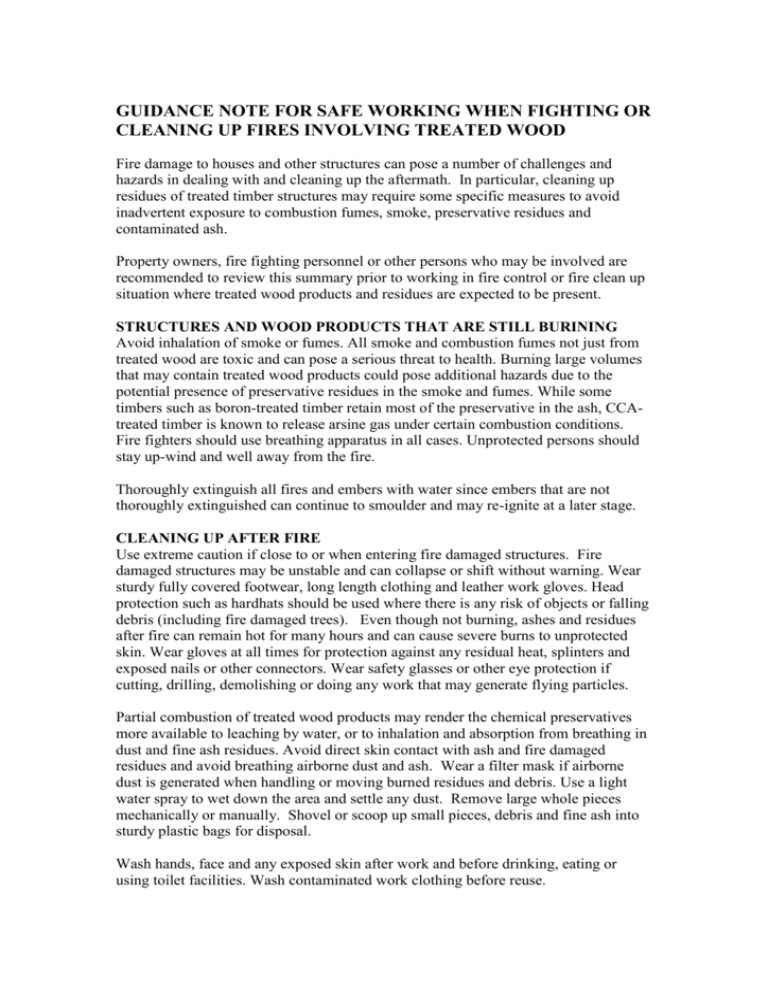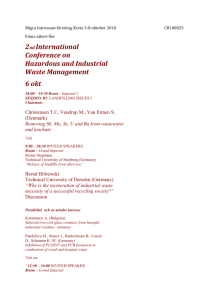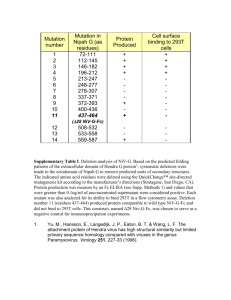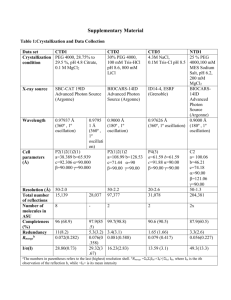Fire Clean-up - TPAA - The Timber Preservers Association of Australia
advertisement

GUIDANCE NOTE FOR SAFE WORKING WHEN FIGHTING OR CLEANING UP FIRES INVOLVING TREATED WOOD Fire damage to houses and other structures can pose a number of challenges and hazards in dealing with and cleaning up the aftermath. In particular, cleaning up residues of treated timber structures may require some specific measures to avoid inadvertent exposure to combustion fumes, smoke, preservative residues and contaminated ash. Property owners, fire fighting personnel or other persons who may be involved are recommended to review this summary prior to working in fire control or fire clean up situation where treated wood products and residues are expected to be present. STRUCTURES AND WOOD PRODUCTS THAT ARE STILL BURINING Avoid inhalation of smoke or fumes. All smoke and combustion fumes not just from treated wood are toxic and can pose a serious threat to health. Burning large volumes that may contain treated wood products could pose additional hazards due to the potential presence of preservative residues in the smoke and fumes. While some timbers such as boron-treated timber retain most of the preservative in the ash, CCAtreated timber is known to release arsine gas under certain combustion conditions. Fire fighters should use breathing apparatus in all cases. Unprotected persons should stay up-wind and well away from the fire. Thoroughly extinguish all fires and embers with water since embers that are not thoroughly extinguished can continue to smoulder and may re-ignite at a later stage. CLEANING UP AFTER FIRE Use extreme caution if close to or when entering fire damaged structures. Fire damaged structures may be unstable and can collapse or shift without warning. Wear sturdy fully covered footwear, long length clothing and leather work gloves. Head protection such as hardhats should be used where there is any risk of objects or falling debris (including fire damaged trees). Even though not burning, ashes and residues after fire can remain hot for many hours and can cause severe burns to unprotected skin. Wear gloves at all times for protection against any residual heat, splinters and exposed nails or other connectors. Wear safety glasses or other eye protection if cutting, drilling, demolishing or doing any work that may generate flying particles. Partial combustion of treated wood products may render the chemical preservatives more available to leaching by water, or to inhalation and absorption from breathing in dust and fine ash residues. Avoid direct skin contact with ash and fire damaged residues and avoid breathing airborne dust and ash. Wear a filter mask if airborne dust is generated when handling or moving burned residues and debris. Use a light water spray to wet down the area and settle any dust. Remove large whole pieces mechanically or manually. Shovel or scoop up small pieces, debris and fine ash into sturdy plastic bags for disposal. Wash hands, face and any exposed skin after work and before drinking, eating or using toilet facilities. Wash contaminated work clothing before reuse. DISPOSAL OF BURNED RESIDUES AND WASTE There is little potential for significant ground or site contamination once the burned residues, debris and ash have been removed. Removal or remediation of site soil is usually not necessary. Livestock should be separated from any large volumes of ash arising from burnt CCA-treated timber, as the ash may have a salty taste and be consumed. For residential or other relatively small-scale incidents, burned residues and ash from structures containing treated wood, should be disposed of together with other site demolition and clean-up wastes. Disposal should be via an appropriate waste disposal facility or licensed waste removal contractor. Residues involving large volumes of treated wood from fire damaged industrial or commercial sites may require characterisation and assessment before disposal. Consult your local waste disposal or other appropriate authority for requirements and procedures. SUMMARY All fires are dangerous to those in proximity to or combating them. Directions from fire fighting authorities and other emergency services should always be followed. Fire damaged sites, structures and materials pose hazards for handling and clean up. Persons undertaking this work should exercise caution and take appropriate personal protection measures. The presence of treated wood products in a fire or the residues after the fire may also pose hazards that are detailed in this summary. Providing that these guidelines and other safe working procedures are followed, there is minimal risk of injury or harm resulting from exposure to treated wood residues in these situations.







